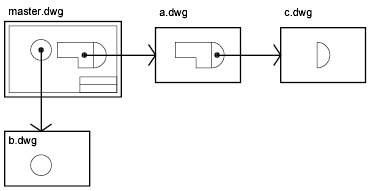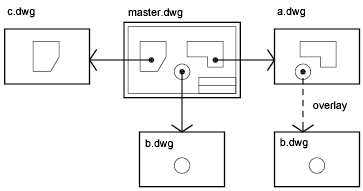Attached DWG references (xrefs) can be nested: that is, you can attach an xref that contains another xref.
Xrefs can be nested within other xrefs: that is, you can attach an xref that contains another xref. You can attach as many copies of an xref as you want, and each copy can have a different position, scale, and rotation.
In the following illustration, master.dwg references a.dwg and b.dwg. Drawing a.dwg references c.dwg. In master.dwg, c.dwg is a nested xref.

You can also overlay an xref on your drawing. Unlike an attached xref, an overlaid xref is not included when the drawing is itself attached or overlaid as an xref to another drawing. Overlaid xrefs are designed for data sharing in a network environment. By overlaying an xref, you can see how your drawing relates to the drawings of other groups without changing your drawing by attaching an xref.
In the following illustration, several people are working on drawings referenced by master.dwg. The person working on a.dwg needs to see the work being completed by the person working on b.dwg, but does not want to xref b.dwg because it would then appear twice in master.dwg. Instead, the person overlays b.dwg, which is not included when a.dwg is referenced by master.dwg.

Relative Saved Paths and Nested Xrefs
The saved path for an xref can be a full path, a relative (partially specified) path, or no path. For a nested xref, a relative path always references the location of its immediate host and not necessarily the currently open drawing.